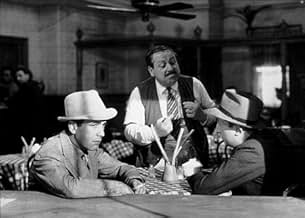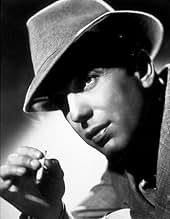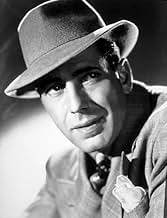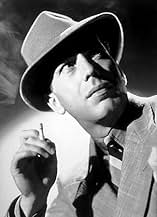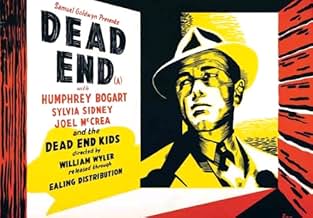CALIFICACIÓN DE IMDb
7.2/10
9.3 k
TU CALIFICACIÓN
Las vidas de un hombre y una mujer jóvenes, un gángster infame y un grupo de niños de la calle convergen un día en un volátil barrio pobre de Nueva York.Las vidas de un hombre y una mujer jóvenes, un gángster infame y un grupo de niños de la calle convergen un día en un volátil barrio pobre de Nueva York.Las vidas de un hombre y una mujer jóvenes, un gángster infame y un grupo de niños de la calle convergen un día en un volátil barrio pobre de Nueva York.
- Dirección
- Guionistas
- Elenco
- Nominado a 4 premios Óscar
- 1 premio ganado y 4 nominaciones en total
Leo Gorcey
- Spit
- (as Leo B. Gorcey)
- Dirección
- Guionistas
- Todo el elenco y el equipo
- Producción, taquilla y más en IMDbPro
Opiniones destacadas
Considering all the talent involved, it was hardly surprising to find this a first rate movie. Didn't you want to slap Bogart around ... well, that is actually what compelled me to make this entry. Among the handful of superlative cameo (say 2 to 8 minutes in length)performances I have seen in my 40 plus years of movie-going, Dead End features one of them.
Marjorie Main, almost as unlikely a film character (think Ma Kettle!) as one could imagine, turned in what I consider a masterpiece. Read that she repeated her stage role, and wow, that slap, that dialog and that role. Bravo!
Marjorie Main, almost as unlikely a film character (think Ma Kettle!) as one could imagine, turned in what I consider a masterpiece. Read that she repeated her stage role, and wow, that slap, that dialog and that role. Bravo!
Dead End the film adaption of Sidney Kingsley's play that ran for 687 performances during the 1935-1937 seasons, was a harbinger of what Alfred Hitchcock tried to do in such films as Rope and even more so in Rear Window. The whole story is told on one very complex set showing the stark contrast of the rich penthouse dwellers with the inhabitants of the nearby tenements and flats.
Building that set on stage and for the screen must have been one expensive proposition so it was a good thing Sidney Kingsley wrote a hit.
It may be one set, but the plot of the film involves three stories and how they interconnect. Story number one is about Joel McCrea, a former slum kid himself who still lives down there while he tries to get a job as an architect. He's involved with two women, rich socialite Wendy Barrie who lives in the penthouse and Sylvia Sidney who played more working class women than anyone else during the Thirties.
Sidney works as a seamstress in a garment factory and she's currently on strike and she's got a younger brother to support who causes her much grief. The younger brother is Billy Halop and Sidney worries about the gang he runs with, the kids who later became known as the Dead End kids, later East Side Kids, later Bowery Boys. Their a rough bunch and they get a visit from a celebrity of sorts.
Which leads us to the third track in the person of Humphrey Bogart who grew up on this same block and is now a wanted fugitive of the John Dillinger variety. The kids and McCrea recognize him, the kids worship him and McCrea is willing to give him a pass for now, he's no rat. All their stories mix in this plot which does hold the interest through out the film.
Besides the Dead End Kids who didn't all play the same roles you see them play on the screen only one other player came over from Broadway for the screen version. Marjorie Main who we usually know as the rambunctious and brassy Ma Kettle plays a very serious part indeed as Humphrey Bogart's mother. You'll not forget her as she rejects her hoodlum son both the anger and sorrow she expresses, it is haunting.
Bogart got another jolt in his trip down memory lane in the slum in the person of Claire Trevor. She's usually a good time girl with a heart of gold. Her heart may be golden in Dead End, but she's a woman who's seen the seamy side of life as a prostitute. Very few prostitutes were portrayed as such during the days of The Code so in that sense Dead End was quite daring.
The film is firmly set in the Depression Thirties. That same area where in certain shots you can see the Queensborough Bridge in the near distance is some of the richest real estate on earth now. Those same buildings that are portrayed as slums now rent to yuppies at obscene figures if in fact they survived.
Though Dead End is a dated piece of work, it does offer a great glimpse into urban life for the rich and poor. This is one of Samuel Goldwyn's best productions and William Wyler gets uniformly fine performances from his talented cast of players.
Building that set on stage and for the screen must have been one expensive proposition so it was a good thing Sidney Kingsley wrote a hit.
It may be one set, but the plot of the film involves three stories and how they interconnect. Story number one is about Joel McCrea, a former slum kid himself who still lives down there while he tries to get a job as an architect. He's involved with two women, rich socialite Wendy Barrie who lives in the penthouse and Sylvia Sidney who played more working class women than anyone else during the Thirties.
Sidney works as a seamstress in a garment factory and she's currently on strike and she's got a younger brother to support who causes her much grief. The younger brother is Billy Halop and Sidney worries about the gang he runs with, the kids who later became known as the Dead End kids, later East Side Kids, later Bowery Boys. Their a rough bunch and they get a visit from a celebrity of sorts.
Which leads us to the third track in the person of Humphrey Bogart who grew up on this same block and is now a wanted fugitive of the John Dillinger variety. The kids and McCrea recognize him, the kids worship him and McCrea is willing to give him a pass for now, he's no rat. All their stories mix in this plot which does hold the interest through out the film.
Besides the Dead End Kids who didn't all play the same roles you see them play on the screen only one other player came over from Broadway for the screen version. Marjorie Main who we usually know as the rambunctious and brassy Ma Kettle plays a very serious part indeed as Humphrey Bogart's mother. You'll not forget her as she rejects her hoodlum son both the anger and sorrow she expresses, it is haunting.
Bogart got another jolt in his trip down memory lane in the slum in the person of Claire Trevor. She's usually a good time girl with a heart of gold. Her heart may be golden in Dead End, but she's a woman who's seen the seamy side of life as a prostitute. Very few prostitutes were portrayed as such during the days of The Code so in that sense Dead End was quite daring.
The film is firmly set in the Depression Thirties. That same area where in certain shots you can see the Queensborough Bridge in the near distance is some of the richest real estate on earth now. Those same buildings that are portrayed as slums now rent to yuppies at obscene figures if in fact they survived.
Though Dead End is a dated piece of work, it does offer a great glimpse into urban life for the rich and poor. This is one of Samuel Goldwyn's best productions and William Wyler gets uniformly fine performances from his talented cast of players.
In "Dead End" the nominal stars are Sylvia Sidney and Joel McCrea but it is the supporting players that steal the picture. Great performances are turned in by the Dead End Kids (Billy Halop, Huntz Hall, Bobby Jordan, Leo Gorcey, Bernard Punsley), Humphrey Bogart, Claire Trevor and Marjorie Main. It also benefits greatly from the direction of William Wyler who keeps the story moving and makes the characters interesting.
"Dead End" was originally produced on the Broadway stage. The Dead End Kids re-enact their Broadway roles. The story takes place on the banks of the East River in New York where posh apartment buildings co-habit the neighborhood with the tenement slums. The plot centers on the activities of the people of the neighborhood one summer's day.
Dave Connell (McCrea) is a struggling architect looking for his big break. Drina (Sidney) is a struggling shop clerk who is involved in a labor dispute and hopes one day to be able to leave the neighborhood. Gangster "Baby Face" Martin (Bogart) returns to his childhood haunts hoping to see his mother (Main) and hook up with his old girlfriend Francey (Trevor). Hanging around the wharf are a group of teenage toughs (The Dead End Kids) one of whom, Tommy (Halop) is the brother of Drina.
The boys taunt rich kid Philip Griswald (Charles Peck) and lure him down to the street. There he is beaten up by the boys. His father (Minor Watson) is highly influential man who insists on justice for his son. One of the boys, "Spit" squeals on his pal and Tommy is arrested after stabbing Mr. Griswald in the hand.
Meanwhile Martin goes to see his mother and is shocked when she slaps him and calls him a murderer. Martin's pal "Hunk" (Allen Jenkins) locates Francey and arranges for her to come meet "Baby Face". Martin is doubly shocked when he learns that his former love has pursued a career on the streets.
During an altercation with Dave over the influencing of the boys, Martin stabs him and throws him into the river, leaving him for dead. Martin then hatches a plot to kidnap the rich kid Philip Griswald. But Dave returns, confronts Martin and..............
This film is arguably Bogey's best film of the 1930s. Oddly enough, it was made on loan out to Samuel Goldwyn. His expressions of surprise and disgust after meeting with his mother and Francey are a treasure to watch. Trevor's performance, however brief, was moving enough to garner her a best supporting actress Oscar nomination. Marjorie Main also only appears briefly but evokes great sympathy in her role as the tragic Mrs. Martin.
The Dead End Kids to a man turn in what are the best performances in the film. They would go on to appear in a series of Warner Bros films in the next two years before moving into several "B" series in the 40s and 50s. Also, look for Ward Bond as the doorman to the rich apartment building and Don "Red" Barry as an abalones doctor.
An excellent film.
"Dead End" was originally produced on the Broadway stage. The Dead End Kids re-enact their Broadway roles. The story takes place on the banks of the East River in New York where posh apartment buildings co-habit the neighborhood with the tenement slums. The plot centers on the activities of the people of the neighborhood one summer's day.
Dave Connell (McCrea) is a struggling architect looking for his big break. Drina (Sidney) is a struggling shop clerk who is involved in a labor dispute and hopes one day to be able to leave the neighborhood. Gangster "Baby Face" Martin (Bogart) returns to his childhood haunts hoping to see his mother (Main) and hook up with his old girlfriend Francey (Trevor). Hanging around the wharf are a group of teenage toughs (The Dead End Kids) one of whom, Tommy (Halop) is the brother of Drina.
The boys taunt rich kid Philip Griswald (Charles Peck) and lure him down to the street. There he is beaten up by the boys. His father (Minor Watson) is highly influential man who insists on justice for his son. One of the boys, "Spit" squeals on his pal and Tommy is arrested after stabbing Mr. Griswald in the hand.
Meanwhile Martin goes to see his mother and is shocked when she slaps him and calls him a murderer. Martin's pal "Hunk" (Allen Jenkins) locates Francey and arranges for her to come meet "Baby Face". Martin is doubly shocked when he learns that his former love has pursued a career on the streets.
During an altercation with Dave over the influencing of the boys, Martin stabs him and throws him into the river, leaving him for dead. Martin then hatches a plot to kidnap the rich kid Philip Griswald. But Dave returns, confronts Martin and..............
This film is arguably Bogey's best film of the 1930s. Oddly enough, it was made on loan out to Samuel Goldwyn. His expressions of surprise and disgust after meeting with his mother and Francey are a treasure to watch. Trevor's performance, however brief, was moving enough to garner her a best supporting actress Oscar nomination. Marjorie Main also only appears briefly but evokes great sympathy in her role as the tragic Mrs. Martin.
The Dead End Kids to a man turn in what are the best performances in the film. They would go on to appear in a series of Warner Bros films in the next two years before moving into several "B" series in the 40s and 50s. Also, look for Ward Bond as the doorman to the rich apartment building and Don "Red" Barry as an abalones doctor.
An excellent film.
Dead End is one of my personal favorites, as I watch it 10 or more times a year. The 1930's New York City setting lends itself to a host of interesting perspectives. The talent assembled for this production is why the film withstands the test of time and makes Dead End a movie which I never get tired of viewing. Greg Toland's cinematography is masterful. Max Steiner's musical score is brilliant. He perfectly blended the feel of a fast paced urban theme which then becomes a beautiful and dramatic orchestral piece. Max Steiner had a real genius for bringing the right mood to whatever the film demanded. Of so many brilliant Steiner scores, I find this to be among his finest. William Wyler's direction is awesome, as always. I particularly like the constant background flow of pedestrians going about their day throughout the entire picture. The movie's cast is stuffed with talent. Character actors like Marjorie Mane and Esther Howard fill small segments with memorable scenes. Claire Trevor's portrayal of a sweet girl who became disillusioned and wound up as a prostitute, is poignant while remaining gritty and realistic. The Dead End Kids are great throughout the movie. Ward Bond brings a plus to the movie in his role as the upscale apartment's doorman. I like Allen Jenkins and think no other actor was better suited to play the sidekick to Bogart's character as the prodigal gangster, returning to his old neighborhood. Dead End is one film that has countless elements to enjoy. The level of talent on both sides of the camera keep me watching it over and over again.
It offers a vivid portrait of people caught up in a continual fight to somehow satisfy themselves despite the oppressive environment that seemed to quiet their every attempt
Joel McCrea is a frustrated architect who dreams of tearing down the slums and Sylvia Sidney portrays a shopgirl struggling for identity and meaning in her life, a life made even more complicated by having to look after her brother (Billy Halop). The boy idolizes the decadent Bogart, an excessive admiration shared by the rest of the Dead End Kids, here recreating their original Broadway roles with noisy good humor
Opposing these idealists is their real threat, Bogart, an assassin named Baby Face Martin Bogart is impolitely rejected by a mother (Marjorie Main) who hates him and an ex-girl friend (Claire Trevor) who leaves him bitter and disillusioned when he discovers that she has become a hooker
Rebuked by those he had been sentimental enough to want to visit, he rapidly reverts to represent beforehand and plans a kidnapping in order to rescue something from the consumed affair
"Dead End" remains one of Bogart's best films, where the actor proves that he is capable of handling difficult material with considerable skill
Joel McCrea is a frustrated architect who dreams of tearing down the slums and Sylvia Sidney portrays a shopgirl struggling for identity and meaning in her life, a life made even more complicated by having to look after her brother (Billy Halop). The boy idolizes the decadent Bogart, an excessive admiration shared by the rest of the Dead End Kids, here recreating their original Broadway roles with noisy good humor
Opposing these idealists is their real threat, Bogart, an assassin named Baby Face Martin Bogart is impolitely rejected by a mother (Marjorie Main) who hates him and an ex-girl friend (Claire Trevor) who leaves him bitter and disillusioned when he discovers that she has become a hooker
Rebuked by those he had been sentimental enough to want to visit, he rapidly reverts to represent beforehand and plans a kidnapping in order to rescue something from the consumed affair
"Dead End" remains one of Bogart's best films, where the actor proves that he is capable of handling difficult material with considerable skill
¿Sabías que…?
- TriviaWilliam Wyler gave Claire Trevor an old purse and broken high heel shoes. He had her minimize her make-up and ordered her not to comb her hair when she got up in the morning. He wanted her to look like the downtrodden character she was playing.
- ErroresBaby Face Martin suddenly appears from nowhere and is leaning against a railing as the boys are fighting.
- Créditos curiososOpening credits prologue: Every street in New York ends in a river. For many years the dirty banks of the East River were lined with the tenements of the poor. Then the rich, discovering that the river traffic was picturesque, moved their houses eastward. And now the terraces of these great apartment houses look down into the windows of the tenement poor.
- ConexionesFeatured in AFI Life Achievement Award: A Tribute to William Wyler (1976)
- Bandas sonorasBoo-Hoo
(1937) (uncredited)
Music by Carmen Lombardo and John Jacob Loeb
Lyrics by Edward Heyman
Played at the upstairs party and sung by Huntz Hall in the street
Selecciones populares
Inicia sesión para calificar y agrega a la lista de videos para obtener recomendaciones personalizadas
- How long is Dead End?Con tecnología de Alexa
Detalles
Taquilla
- Presupuesto
- USD 300,000 (estimado)
- Tiempo de ejecución
- 1h 33min(93 min)
- Color
- Relación de aspecto
- 1.37 : 1
Contribuir a esta página
Sugiere una edición o agrega el contenido que falta



